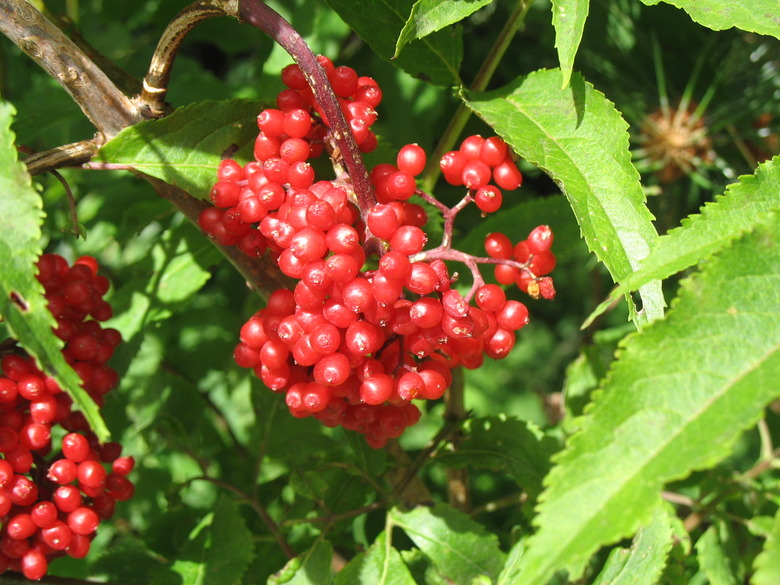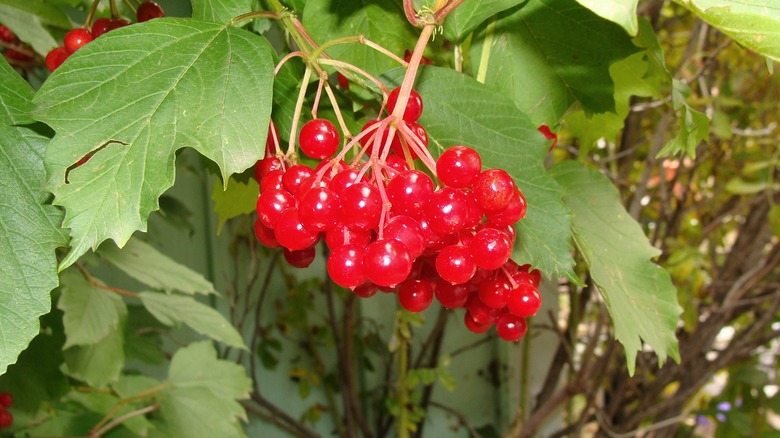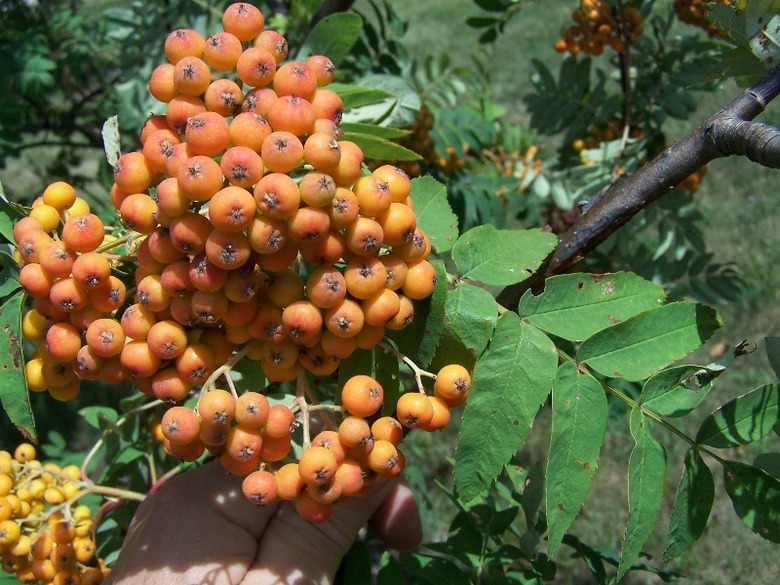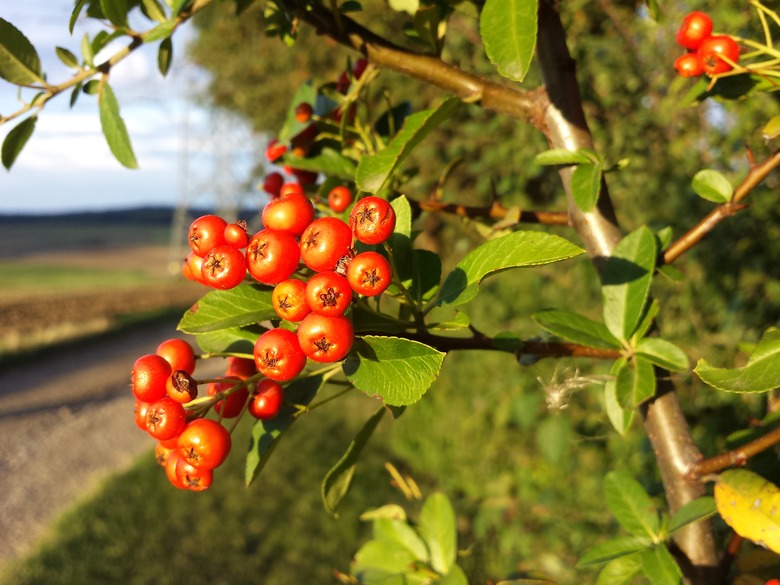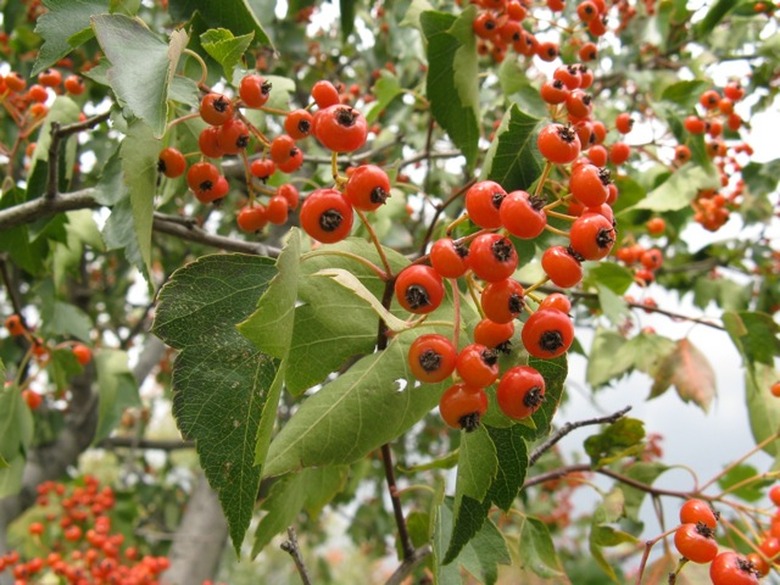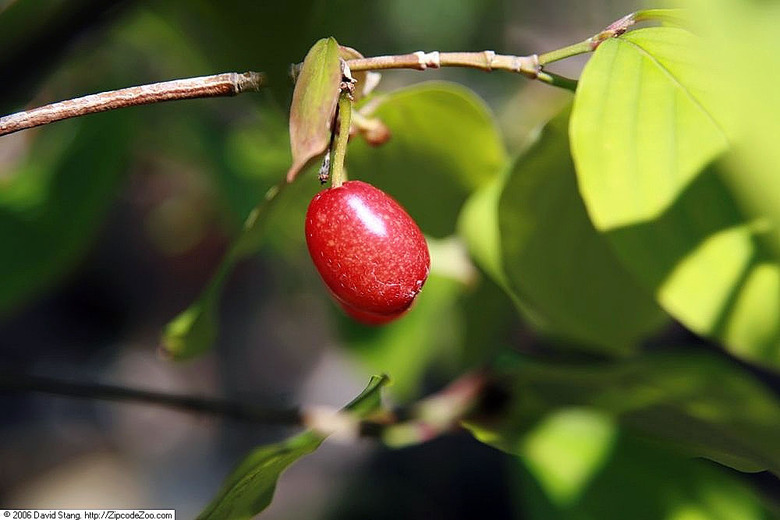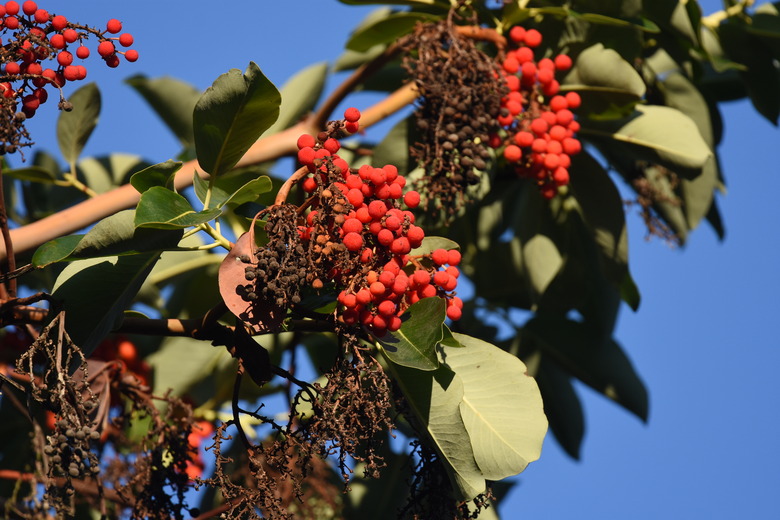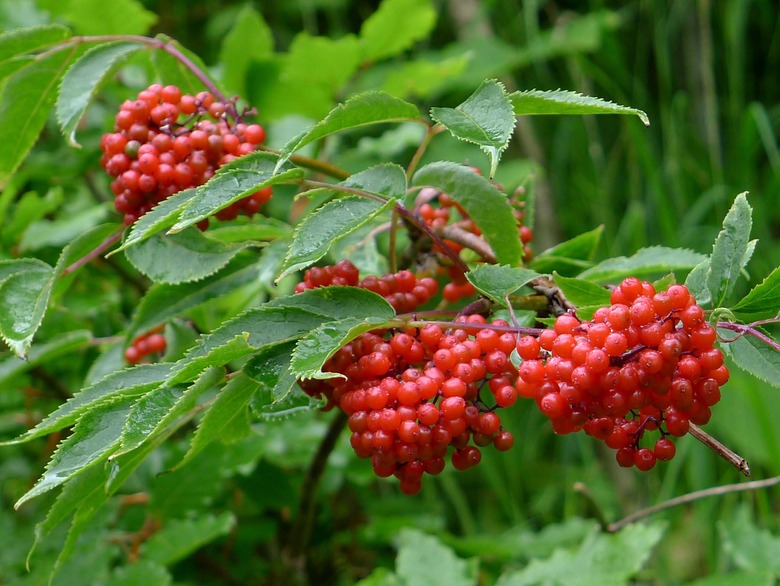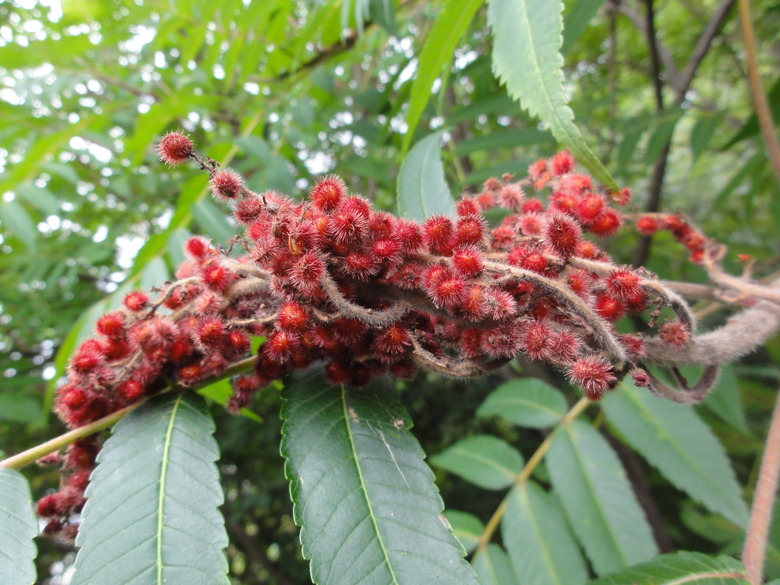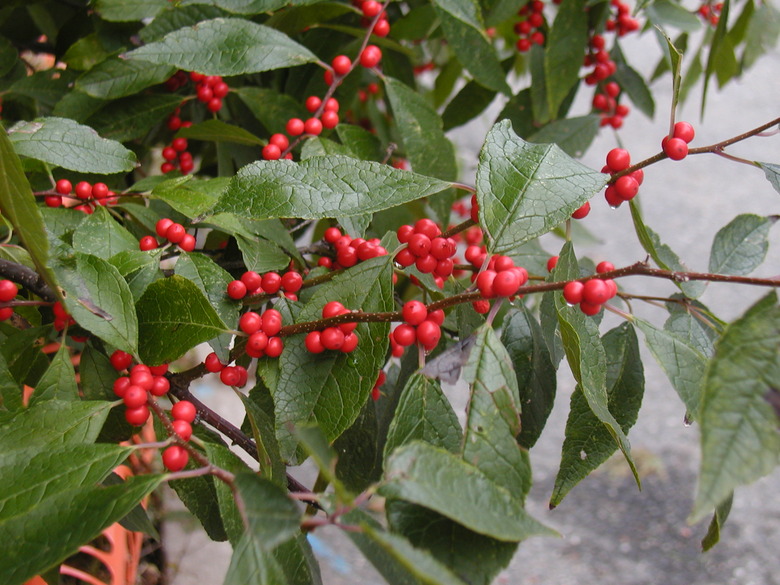How To Identify A Tree With Red Berries
Flowering and fruiting trees in the landscape add beauty and value to the property as well as forage for wildlife and—sometimes—humans. Before harvesting and enjoying the red berries on a tree, however, it's important to ensure that the fruits are human-safe and tasty additions to the family kitchen.
To identify a tree with red berries, consider the local U.S. Department of Agriculture plant hardiness zone, the size, growth pattern and environment, as well as the bark, leaves, flower and fruit shapes, sizes and colors.
Red Berry Tree Identification
To identify a tree, collect all the information available. The process may take extra time if it's not the flowering or fruiting season, so keep a log or notebook to document the identifying factors of the tree. A camera, ruler and tape measure are helpful in maintaining a log as the tree passes through the seasons of a full year.
Because a woody plant may be trimmed to a tree form with one or more trunks, be aware that the plant in the garden may actually be a large shrub. So use the bark, leaves, flowers and fruits to determine the species and edibility of the red berries.
Also take pictures of the tree and its various identifying features, such as when the flowers bud out or leaves have fallen, which will help identify it when comparing it to other similar plant descriptions.
The first step in identifying a tree with red berries is by documenting the environmental factors where it is growing. Begin by determining the following:
- What is the local USDA zone?
- Is it growing in sun or shade?
- Is the soil sandy, loam or clay?
- Is the soil dry, average, moist or wet?
Document the Tree
Take a look at the tree. Does it have one trunk, multiple woody stems or require regular removal of root suckers to prevent it from spreading through the garden? A single trunk may indicate a tree, while multiple stems or root suckers may indicate that it is a large shrub that naturally produces multiple stems to make a thicket.
Take out the tape measure and measure the height and width of mature plants, as the size may help determine not just the species, but also the cultivar.
Large trees and shrubs may need creative solutions to find an approximate measure, such as comparing the height to the house. Alternatively, if the plant is equally tall and wide, measure the width to find the height.
Tip
Take out the tape measure and measure the height and width of mature plants, as the size may help determine not just the species, but also the cultivar.
Inspect the Bark
Inspect the bark carefully. Texture, thickness, color, thorns and/or peeling bark are helpful indicators, though some cultivars may not have the thorns sported by the species plants.
Bark colors range from off-white to green to gray to brown and reddish browns to purple, depending on the species and cultivar. Some trees have green bark when young that matures to a darker shade of green or other color as the tree ages.
Examine the Leaves
Leaves vary wildly in color, size and shape. A leaf may be tiny, medium-sized, large or huge, and thin or wide. It can also have smooth or serrated edges or be rounded, oblong or compound, simple or with several leaflets.
Leaf colors may change from a bright chartreuse or red in spring to deep green or bronze-red in summer to brilliant yellows, oranges or reds in fall. The leaves may drop from the tree or stay green year round.
Look at the Flowers
Place a ruler next to a bud and then a fully-opened blossom and take a picture. Note the color, number of petals and other parts of the flower. Smell the flower and write down the scent, if any. Also indicate if the flowers grow singly or in clusters, amid the foliage or on the branch tips.
Check the Berries
The red fruits on the tree may actually be berries, drupes or pomes. They may range in color from pale reddish-pink to orange-red to crimson to deep red or burgundy. Berry sizes may be tiny or small, with many seeds or one large seed.
Until it's determined that the berries are edible by humans, don't taste them and in some cases, even if edible, the seeds may not be safe to ingest.
Trees and Shrubs With Red Berries
There are a number of trees and shrubs, both native and imported, that may be found in the garden or growing wild. When identifying trees with red berries, if in doubt of the species, consult with the county extension service or a local tree expert.
Meanwhile, here's a few relatively common trees and shrubs found in landscapes and growing wild across the United States.
American Cranberry Bush
The American cranberry bush is an upright shrub native to the northern states and Canada. It may be found in the wild or used as an ornamental shrub, foundation planting or hedge.
To distinguish between the native shrub and hybrids of the American and European (Viburnum opulus, zones 2 to 8) cranberry bush varieties, look at the top of the leaf stalk where it connects to the base of the leaf. It should be bulging outward or columnar if the shrub is the native species. The European berries are bitter and not considered edible by humans.
- **Scientific Name:** Viburnum opulus var. americanum.
- **Common Names:** American cranberry viburnum, American viburnum, cranberry, highbush cranberry.
- **Type:** Deciduous shrub.
- **Size:** 8 to 12 feet tall and wide.
- **Light:** Full sun to partial shade.
- **Soil:** All moist to wet, well-draining soil types.
- **Water Needs:** Average.
- **Bark:** New stems, thin, smooth green to reddish, mature to scaly dark brown or dark gray.
- **Leaves:** 3 to 6 inches long, dark green above and hairy veins below, three-lobed, maple-like, coarsely serrated edges; yellow-red to reddish-purple fall color.
- **Flowers:** 2 1/2 to 4 inches wide, white flat-topped clusters of sterile flowers outside and tiny flowers with yellow anthers inside; flowers bloom late spring to summer.
- **Fruits:** Bright red berries (drupes) in clusters, less than 1-inch diameter, flattened, one seed. Sweeter than true cranberries (Vaccinium macrocarpon, zones 3 to 7).
- **USDA Zones:** 2 to 7.
American Mountain Ash
Native to the Northeast, from Newfoundland to as far south as Georgia, the American mountain ash features an open, rounded canopy. Although an understory tree, it prefers full sun and tolerates partial shade. It may be found in cool climates as a shade tree, although it is intolerant of urban pollution.
The berries are enjoyed by birds and wildlife, though too acidic for humans when fresh off the bush or tree. With the addition of plenty of sugar, the berries are usually made into jelly.
- **Scientific Name:** Sorbus americana.
- **Common Names:** American rowan, mountain-ash.
- **Type:** Deciduous shrub or small tree.
- **Size:** 15 to 35 feet tall and 8 to 25 feet wide.
- **Light:** Full sun to partial shade.
- **Soil:** Acidic, organically-rich, moist but well-draining loam to clay soils.
- **Water Needs:** Average.
- **Bark:** Smooth light gray when young, matures to scaly with cracks and splits.
- **Leaves:** 6 to 10 inches long, dark yellow-green with lighter undersides, compound leaves with 2-to-4-inch leaflets, rounded or wedge-shaped bases. New leaves are downy; leaves turn yellow in fall.
- **Flowers:** Creamy white, 1/4- to 1/8-inch-wide urn-shaped flowers with four petals appearing in 3- to 6-inch-wide flattened clusters; blooms appear in early summer.
- **Fruits:** Orange-red to red-burgundy, 1/4-inch-diameter berries (pomes) in clusters. Ripens from late summer to fall.
- **USDA Zones:** 2 to 6.
Pyracantha or Scarlet Firethorn
Pyracantha is grown as an ornamental shrub, espalier or protective hedge, due to its dense foliage and sharp thorns. Wear rose gloves, safety goggles and other safety gear when pruning and working around the shrubs to protect skin and eyes from the sharp thorns.
Native to southern and south-central Europe and the Middle East, pyracantha has naturalized in the U.S. While the white flowers are attractive, they also have a foul stench that discourages their use as foundation plantings and near windows.
The red berries are eaten by birds and wildlife, but not humans, and while not considered toxic, they may result in a stomachache if ingested in large amounts.
- **Scientific Name:** Pyracantha coccinea, previously Cotoneaster pyracantha.
- **Common Names:** Egyptian thorn, everlasting thorn, fire bush, firethorn, scarlet pyracantha.
- **Type:** Semi-evergreen to evergreen shrub.
- **Size:** 6 to 18 feet tall and wide.
- **Light:** Full sun to partial shade.
- **Soil:** All acidic to neutral, well-draining soil types.
- **Water Needs:** Average.
- **Bark:** Reddish brown, covered with soft hairs when young. Matures to smooth and glossy with thorns.
- **Leaves:** 1 to 2 1/2-inch-long narrow somewhat egg-shaped with rounded or pointed tips, shiny dark green on top and fuzzy and lighter green underneath, alternated on the branch.
- **Flowers:** White, 1/3-inch-wide five-petal flowers in 2- to 3-inch-wide clusters in spring to early summer. Emits a foul scent when in bloom.
- **Fruits:** 1/4-inch diameter orange-red to crimson berries (pomes) in tight clusters.
- **USDA Zones:** 6 to 9.
Hawthorn Trees and Shrubs
The hawthorns (Crataegus spp.) are a group of trees and shrubs in the rose family (Rosaceae). While there are hundreds of species and cultivars used in the landscape, many share the common features of beautiful flowers: small, apple-like berries and sharp thorns.
While the hawthorn tree in the landscape may be one of many species, the red mayhaw tree is one commercially-available cultivar grown in landscapes in USDA zones 6 and above. A host plant for a number of butterfly species, this native North American tree also attracts pollinators and wildlife to the garden. The tart fruits are used to make jellies, preserves and pies or dried like cranberries.
- **Scientific Name:** Crataegus aestivalis.
- **Common Names:** Apple hawthorn, eastern mayhaw, hawthorn, mayhaw, may hawthorn, thornapples.
- **Type:** Deciduous shrub or tree.
- **Size:** 10 to 40 feet tall and 35 to 40 feet wide.
- **Light:** Full sun to partial shade.
- **Soil:** All moist to wet soil types.
- **Water Needs:** Average to heavy.
- **Bark:** Thin, silver-gray, matures to thin scales. Branches are crooked and thorn-covered.
- **Leaves:** Dark green with red-brown undersides, 3 to 6 inches long, egg- and wedge-shaped, serrated edges and often three-lobed.
- **Flowers:** White, 1-inch-wide, five-petal flowers in clusters, appearing in early spring.
- **Fruits:** Red to burgundy, approximately 1-inch-diameter berries (pomes).
- **USDA Zones:** 6 to 11.
The Washington hawthorn boasts fall color as well as edible fruits and sharp thorns. Tolerant of urban pollution, it can be used as a hedge, focal point or street tree.
The 1-to-3-inch spiky thorns require rose gloves and other safety gear to prevent puncture wounds when working around the tree. However, the cultivars Fastigiata and Princeton Sentry are nearly thornless. Like other hawthorns, it attracts bees, butterflies, songbirds and other wildlife to the garden.
- **Scientific Name:** Crataegus phaenopyrum, previously Cotoneaster cordatus, Crataegus populifolia.
- **Common Names:** Hawthorn, thornapple.
- **Type:** Deciduous tree.
- **Size:** 25 to 30 feet tall and 20 to 25 feet wide.
- **Light:** Full sun to partial shade.
- **Soil:** All soil types.
- **Water Needs:** Average to heavy, drought resistant.
- **Bark:** Thin gray bark with 1- to 3-inch thorns; develops narrow scales and flaking bark that reveals orange-red inner bark as the tree matures.
- **Leaves:** Glossy dark green leaves with lighter undersides, 1 to 3 inches long and 1/4 to 2 1/4 inches wide, triangular to egg-shaped with three to five lobes and serrated edges. Orange, red, purple fall color.
- **Flowers:** White, 1/2-inch-wide four to five-petal flowers in clusters containing up to 50 blossoms. Scent may be unpleasant to some humans.
- **Fruits:** Shiny bright red to burgundy, 1/4-inch-diameter berries (pomes) in clusters.
- **USDA Zones:** 4 to 8.
Japanese Cornelian Dogwood
The yellow flowers that cover the bare branches of the Japanese cornelian dogwood in late winter and early spring make this large shrub or small tree a focal point in the garden. Pruned to a multi-stemmed tree form, this dogwood prefers a little afternoon shade in warmer climates.
The red fruits mature in fall, attracting pollinators, birds and wildlife. While not toxic, their acidic flavor discourages human consumption.
- **Scientific Name:** Cornus officinalis, previously Cornus officinalis var. koreana, Macrocarpium officinale.
- **Common Names:** Chinese cornelian dogwood, Japanese cornelian cherry dogwood, Japanese cornelian dogwood, Korean cornelian dogwood.
- **Type:** Deciduous shrub or tree.
- **Size:** 15 to 30 feet tall and 15 to 25 feet wide.
- **Light:** Full sun to partial shade.
- **Soil:** Acidic, organically-rich, well draining soils.
- **Water Needs:** Average.
- **Bark:** Dark grayish brown, peels to expose orange inner bark.
- **Leaves:** Dull green on top, lighter underneath with reddish-brown hairs along the veins, 2 to 4 inches long and 1 to 1 1/2 inches wide, egg-shaped to oblong or pointed. Dull yellow to reddish-purple fall colors.
- **Flowers:** Yellow, tiny, four to five-petal flower clusters surrounded by drooping yellow bracts; flowers appear in later winter and early spring.
- **Fruits:** Bright red to purplish-red, 1/4-inch-long and 1/8-inch wide berries (drupes) with one seed. Very acidic, not palatable to humans.
- **USDA Zones:** 5 to 8.
Pacific Madrone Tree
The Pacific madrone, a West Coast native, is found in open woodlands from British Columbia to as far south as Mount Palomar in San Diego County, California. It features red-brown peeling bark that reveals the inner layer of new green to red-orange bark.
While attractive, Pacific madrone doesn't transplant well. It prefers well-draining soils ranging from dry to evenly moist. The urn-shaped flowers attract hummingbirds, and the resulting berries are a winter food source for birds and wildlife. While edible, the berries are mealy and not tasty.
- **Scientific Name:** Arbutus menziesii.
- **Common Names:** Madrona, madrone.
- **Type:** Evergreen tree.
- **Size:** 15 to 65 feet tall and 10 to 50 feet wide.
- **Light:** Full sun to partial shade.
- **Soil:** Acidic to neutral, well draining clay to loam soils.
- **Water Needs:** Light to average, prefers dry to evenly moist soils.
- **Bark:** Thin reddish brown bark peels, revealing green to red-orange or copper-colored new bark underneath.
- **Leaves:** Glossy dark green, 5 inches long and 2 inches wide, leathery with smooth edges.
- **Flowers:** Creamy white, less than 1-inch urn-shaped flowers in 3- to 9-inch-long branching clusters; flowers appear in spring.
- **Fruits:** Bright orange-red, 1/2- to 3/4-inch berries with multiple seeds.
- **USDA Zones:** 7 to 9.
Red Elderberry Shrub
The native red elderberry is a large shrub that spreads by root suckers. Prune in late winter to keep the shrub at a manageable size and remove the root suckers when they appear to prevent the shrub from growing into a thicket, or allow the suckers to grow along the sides to make a hedge or privacy screen.
While previously separate, European red elderberry (Sambucus racemosa, USDA zones 3 to 7) and North American red elderberry are now grouped together as one species. Like other elderberries, the tart red berries can be cooked and processed to make syrups and pies.
- **Scientific Name:** Sambucus racemosa, previously Sambucus racemosa subsp. pubens, Sambucus pubens.
- **Common Names:** Red-berried elder, scarlet elder, scarlet elderberry.
- **Type:** Deciduous shrub.
- **Size:** 4 to 25 feet tall and 3 to 25 feet wide.
- **Light:** Full sun to partial shade.
- **Soil:** All medium to wet, well-draining soil types, but prefers acidic to neutral pH.
- **Water Needs:** Average to heavy.
- **Bark:** New bark is reddish- to greenish-gray, sometimes hairy; matures to a smooth reddish- to grayish-brown with rounded, raised pores.
- **Leaves:** Dark green, 6- to 9-inch compound leaves with five to seven 4-inch leaflets.
- **Flowers:** Creamy white, 3- to 6-inch upright clusters of 1/8-inch-wide flowers appear in spring and early summer. Scent may be unpleasant.
- **Fruits:** Bright red to dark red, 1/8- to 1/6-inch round berries with three seeds.
- **USDA Zones:** 3 to 7.
Warning
All elderberry species contain toxic compounds that make humans, pets and horses sick if eaten. The safest way to enjoy elderberries is by cooking to break down the toxic elements. Elderberries are usually made into syrups, jams and jellies, pies and wine.
Staghorn Sumac Shrub
This shrub's crooked trunk, branches and velvety twigs combine with the fall and winter red berries clinging to the bare stems make it a colorful addition to the winter garden. The shrub spreads by root suckers and can become a thicket of single-sexed plants if not pruned regularly; only the female plant produces berries.
The tart berries attract birds and wildlife and can be made into a lemonade-like beverage for humans to enjoy.
- **Scientific Name:** Rhus typhina, previously Datisca hirta, Rhus hirta, Rhus typhina var. laciniata.
- **Common Names:** Staghorn sumac, sumac, velvet sumac.
- **Type:** Deciduous shrub or tree.
- **Size:** 8 to 25 feet tall and wide.
- **Light:** Full sun to partial shade.
- **Soil:** Acidic, well-draining, rocky soils.
- **Water Needs:** Low to average.
- **Bark:** Thin reddish-brown to red or burgundy with reddish-brown fuzzy hairs when young; matures to smooth, then scaly light brown or gray with raised pores.
- **Leaves:** Bright green on top and fuzzy underneath, up to 24-inch compound leaves with 13 to 27 2-to 5-inch leaflets, serrated, oblong and pointed; leaves turn yellow, orange or red in fall.
- **Flowers:** Greenish-yellow, 1/4-inch five-petal flowers in 4- to 8-inch upright clusters, appearing in late spring and early summer.
- **Fruits:** Bright red to dark red, 1/8-inch fuzzy berries (drupes) in upright clusters.
- **USDA Zones:** 3 to 9.
Winterberry or Winterberry Holly
Native to central and eastern North America, the winterberry thrives in all soil types but prefers acidic, organically rich, moist loam. The shrubs or trees are single sexed; only the female plants produce the red berries in fall.
While winterberries provide winter forage for birds and wildlife, they are not edible.
- **Scientific Name:** Ilex verticillata.
- **Common Names:** Black alder, common winterberry.
- **Type:** Deciduous shrub or tree.
- **Size:** 3 to 15 feet tall and wide.
- **Light:** Full sun to deep shade.
- **Soil:** All acidic, average to occasionally wet, well-draining soil types.
- **Water Needs:** Average to heavy.
- **Bark:** Red-purple, green, olive- or purple-brown, and fuzzy or hairy twigs; matures to smooth gray or blackish with knobby pores.
- **Leaves:** Dark green, fuzzy along veins with 2- to 3-inch serrated leaves, egg-shaped or rounded.
- **Flowers:** Greenish-white, white or yellow; 1/4- to 1/2-inch four to six petal flowers in clusters along leaf axils; dark red or maroon fall color; flowers are inconspicuous and appear in early summer.
- **Fruits:** Orange to bright red or burgundy, 1/4-inch berries (drupes) with a black dot on the end, three to six seeds in each berry; fruits are found on short stems amid the leaves.
- **USDA Zones:** 3 to 9.
Warning
Winterberries are considered toxic to humans, pets, horses and livestock. The toxic compounds in the fruits and leaves may cause vomiting, diarrhea and other gastric distress. Avoid planting where children and pets can access the berries.
References
- Washington State Magazine: Wild Berries
- Purdue University Extension: Identifying Trees
- North Carolina Extension Gardener Plant Toolbox: Viburnum opulus var. americanum
- Missouri Botanical Garden: Sorbus americana
- North Carolina Extension Gardener Plant Toolbox: Pyracantha coccinea
- National Capitol Poison Center: Are Pyracantha Berries Poisonous?
- North Carolina Extension Gardener Plant Toolbox: Crataegus aestivalis
- North Carolina Extension Gardener Plant Toolbox: Crataegus phaenopyrum
- Missouri Botanical Garden: Cornus officinalis
- Children's Hospital of Philadelphia: Nonpoisonous Berries
- Missouri Botanical Garden: Arbutus menziesii
- North Carolina Extension Gardener Plant Toolbox: Sambucus racemosa subsp. pubens
- Missouri Botanical Garden: Rhus typhina
- North Carolina Extension Gardener Plant Toolbox: Ilex verticillata
- University of Minnesota Extension: Winterberry
